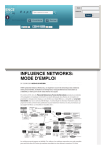Download (N)ERD service manual
Transcript
(N)ERD service manual
1. Overview..........................................................................................................................................1
2. Build and set up environment for local deployment........................................................................1
3. Build and set up environment for remote deployment.....................................................................1
4. Use of (N)ERD console....................................................................................................................2
5. (N)ERD REST API..........................................................................................................................4
6. REST API response examples........................................................................................................18
Authors: Patrice Lopez
Last update: 02.10.2015
1.
Overview
(N)ERD - (Named-)Entity Recognition and Disambiguation - includes a RESTful service
implementation for consuming the entity recognition and disambiguation processes.
2.
Build and set up environment for local deployment
To build the (N)ERD service for local deployment, you just have to go to the root of the project and
run the following command:
> cd nerd;
> mvn clean install
Then deploy the generated war to the server. The artifact is under:
nerd/target/fr.inria.nerd-<version>.war
As an alternative, it is also possible to quick-start and test the service with jetty:
> mvn -Dmaven.test.skip=true jetty:run-war
3.
Build and set up environment for remote deployment
To build (N)ERD for remote deployment, you have to go to the root of the project and run the
following command:
mvn clean install -PgenericBuild
It will generate 2 artifacts, 1 for the text mining data (nerd-data-<version>.zip) and the deployable
war (fr.inria.nerd-<version>.war):
nerd/target/nerd-data-<version>.zip
nerd/target/fr.inria.nerd-<version>.war
Copy these 2 artifacts to your remote server.
nerd-data-<version>.zip contains the needed native libraries, the models, lexicons, gazetteers and a
config directory that contains 2 properties files nerd.properties and nerd_service.properties.
You have to unzip nerd-data wherever you want on your server.
unzip nerd-data-<version>.zip
In fr.inria.nerd-<version>.war, the file web.xml has 3 parameters to set before starting the server:
•
fr.inria.nerd.property: path to nerd.property
•
fr.inria.nerd.property.service: path to nerd_service.properties
•
fr.inria.nerd.home: path to nerd_home
These properties are filled by the following variables:
_NERD_PROPERTY, _NERD_SERVICE_PROPERTY, and _NERD_HOME, so that it is possible
to fill these values with a script given the environment. It is also possible to set manually these
variables.
4.
Use of (N)ERD console
Welcome page is available at http://<server instance name>/<root context name> (i.e: for local
tomcat http://localhost:8080/<name of the war deploy in webapp>).
Type of
request
URL
Requesting Parameter
type
name
General
/nerd
GET
N/A
MIME Type
Request input
type
Response
outputype
N/A
text/html
Description
Gives a very brief description about
the (N)ERD service.
This “welcome resource” is accessed by the “About” section (Fig. 4.1). From there, it is possible to
access the service interface "Service" (Fig. 4.2) and the administration section (Fig 4.3):
Fig 4.1: About
Fig 4.2: Test Rest Interface
Fig 4.3: Service administration
The web page "Service" (Fig. 4.2) allows to test the different REST requests quickly. In the source
code, the class NerdRestService is the entry point for each rest service of the (N)ERD services.
The administration section "Admin" (Fig 4.3) allows to manage dynamically the properties
contained in nerd.properties and nerd_service.properties.
Finally the "Doc" section gives access to the present manual.
5.
(N)ERD REST API
5.1.
Administration services
These services make possible the modification the property values dynamically while the server is
deployed. For instance it is possible to modify the nerd_home path or the ElasticSearch instance
when new models and resources are available/indexed. This is a standard production requirement.
The table below shows the provided resources corresponding to the HTTP verbs to use the
administration services. All url described bellow are relative path, the root url is http://<server
instance name>/<root context>/service/.
The console web application calls these services and can be used to administrate the (N)ERD
deployment or can be exploited as javascript reference client implementation.
Type of request
URL
Parameter
name
Requesting
type
MIME Type
Request input type
/admin
POST
application/x-www-formurlencoded
sha1
/admin?sha1=<pwd>
GET
String
/sha1
POST
application/x-www-formurlencoded
sha1
Administration
/sha1?sha1=<input string>
GET
String
/allProperties
POST
application/x-www-formurlencoded
sha1
/allProperties?
sha1=<password>
/changePropertyValue
text/html
Request to get parameters of nerd.properties and
nerd_service.properties formatted in html table.
text/html
Request to get an input string hashed using sha1.
Request to get all properties key/value/type as xml.
Sent xml follow the following schema:
text/xml
GET
String
POST
application/x-www-formurlencoded
xml
/changePropertyValue?
xml=<some xml>
Response output Description
type
Change the property value from the property key
passed in the xml input. Xml input has to follow the
following schema:
text/xml
GET
String
<properties>
<property>
<key>key</key>
<value>value</value>
<type>type</type>
</property>
<property>...</property>
</properties>
<changeProperty>
<password>pwd</password>
<property>
<key>key</key>
<value>value</value>
<type>type</type>
</property>
</changeProperty>
5.2.
Language identification
For preliminary check, a language identification service is available.
Type of request
URL
Requesting
type
Parameter
name
MIME Type
Request input type
Response output Description
type
Identify the language of a fragment of text.
Language
identification
/processLIdText
POST, PUT
text
multipart/form-data
application/json
Answer: JSON with identified language (ISO 639-1)
and confidence score:
{"lang":"en","conf":1}
> curl -X POST http://localhost:8090/service/processLIdText?text=Bonjour
> {"lang":"fr","conf":0.7142846023142064}
5.3.
Sentence segmentation
This service segments a text into sentences. It is useful in particular for the interactive mode for indicating that only certain sentences need to processed
for a given query. Beginning and end of each sentence are indicated with offset positions with respect to the input text.
Type of request URL
Requesting
type
Parameter
name
MIME Type
Request input type
Response output Description
type
Segment a text into sentences.
Sentence
segmentation
/processSentenceSegmentation POST, PUT text
String
application/json
Answer: JSON with offsets for each sentences:
{ "sentences" : [
{ "offsetStart" : 0, "offsetEnd" : 6 },
{ "offsetStart" : 6, "offsetEnd" : 21 }
]
}
> curl -X POST 'http://localhost:8090/service/processSentenceSegmentation?text=I+eat.+Then+I+spleep.'
> { "sentences" : [ { "offsetStart" : 0, "offsetEnd" : 6 }, { "offsetStart" : 6, "offsetEnd" : 21 } ] }
5.4.
NERD text processing
Two services performing named entity recognition and disambiguation are available:
–
processNERDText for processing raw text fragment, resulting in a structured response containing the different annotations,
–
processNERDQuery, dedicated to interactive applications, which consumes as input a structured JSON query following the format of the
(N)ERD annotated text and which produces a re-processed structured response.
These services are restricted to a set of 26 classes of names entities (see https://github.com/kermitt2/grobid-ner/wiki/Grobid-NER-classes-and-senses).
If covered by Wikipedia/FreeBase, the service will try to disambiguate the recognized named entities. Entities not covered by these knowledge bases
will be characterized by an entity class, a word sense estimation and a confidence score.
In addition, two similar services are provided performing free disambiguation. Without entity class restriction, the service tries to disambiguate all the
entities covered by Wikipedia/FreeBase. However, in this case the entities not present in the knowledge base will not be recognized and characterized
at all:
–
processERDText for processing raw text fragment, resulting in a structured response containing the different annotations,
–
processERDQuery, dedicated to interactive applications, which consumes as input a structured JSON query following the format of the ERD
annotated text and which produces a re-processed structured response.
5.4.1.
processNERDText and processERDText
This is the base NERD/ERD service to be used on raw text fragment.
Note that the language identifier will be applied as a starting point of the process to ensure that the language of the text is supported by the system. In
the current version, only English, French and German are supported by the ERD services, and only English is supported by the NERD services. If
the language of the text is not supported, an http error 406 (request not acceptable) is sent back. The different possible parameters are described bellow.
The two services processNERDText and processERDText use exactly the same arguments/parameters and differ only with respect to the explanations
given in 5.4.
Type of request
Named Entity
Recognition and
Disambiguation
Requesting type Parameter
name
URL
/processNERDText
/processERDText
POST, PUT
text
onlyNER
nbest
sentence
format
customisation
MIME Type
Request input type
Response output Description
type
String
boolean
boolean
boolean
String
String
Perform a Named Entity Recognition and
Disambiguation on a text: identify entities and classify
application/json them in term of NER types and, when possible,
subtypes. Entity resolution against Wikipedia &
FreeBase.
The request is an HTTP GET or POST with the following query parameters:
text
Text to be processed in UTF-8
Mandatory - Default: none
onlyNER
Boolean indicating if the process should be limited to Named Entity Recognition, without disambiguation and resolution against
Wikipedia and Freebase. Performing only NER results in much faster processing time.
Optional – Default: false
nbest
Boolean indicating if only the best disambiguation results should be returned for an identified entity or several best hypotheses.
Optional – Default: false
sentence
Boolean indicating if a sentence segmentation should be present in the returned result.
Optional – Default: false
format
String indicating if the response format is JSON only or JSON+TEI.
Optional – Default: JSON
customisation
Indicate the name of a domain customisation, or generic if no particular customisation is used.
Optional – Default: generic
> curl -X POST 'http://localhost:8090/service/processNERDText?text=John+Smith&onlyNER=true'
> {"text": "John Smith", "runtime": 3, "language": {"lang":"de", "conf": 0.5714286566545531}, "entities": [{ "rawName" : "John Smith",
"type" : "PERSON", "offsetStart" : 0, "offsetEnd" : 10, "conf" : "0.8", "prob" : "1.0" }]}
5.4.2.
processNERDQuery and processERDQuery
This NERD service supports interactive usage, where a user can manually pre-annotate or correct some annotations and the client application might
sends the corrected annotated text to the service several time. There is only a unique parameter which is a JSON string representing a query. This query
is similar to the base response of the NERD/ERD service.
When annotations are present in the query, the NERD system will consider them certain and:
– ensure that the user annotations will be present in the output response without inconsistencies with other annotations,
– exploit the user annotations to improve the context for identifying and disambiguating the other possible entities.
The client must respect the JSON format of the NERD/ERD response as new query, as described bellow.
Type of request
Named Entity
Recognition and
Disambiguation
URL
/processNERDQuery
/processERDQuery
Requesting
type
POST, PUT
Parameter
name
query
MIME Type
Request input type
Response output Description
type
application/json
Perform a Named Entity Recognition and
Disambiguation on a text: identify entities and classify
application/json them in term of NER types and, when possible,
subtypes. Entity resolution against Wikipedia &
FreeBase.
1) The JSON format for the query parameter to be sent to the service is identical to a response of the service. The parameters of the processNERDText
are attribute of the JSON, which typically follow a template like the following one:
{
"text": "The text to be processed.",
"language": {
"lang": "en"
},
"entities": [],
"resultLanguages" : ["fr,"de"]
"onlyNER": false,
"nbest": 0,
"sentence": false,
"format": "JSON",
"customisation": "generic"
}
An additional available parameter is resultLanguages. This parameter is a list of language codes and permits to get the wikipedia pages in additional
languages if they exist (currently only English, German and French wikipedia are supported). In this example the processNERDText service optional
parameters (onlyNER, nbest, sentence, format, customisation) are set to their default values (they remain optionals). The 'entities' attribute is here
empty, which means that there is no pre-defined annotation. Apart from the source language which is pre-set (consequently the language is considered
certain, and the language identifier will not be used) and additional target languages of results, this example is similar to a processNERDText request
but in a JSON format.
2) In the following example, a pre-defined entity (typically pre-annotated by a user) is present in the 'entities' attribute:
{
"text": "Austria invaded and fought the Serbian army at the Battle of Cer and Battle of Kolubara
beginning on 12 August.",
"language": {
"lang": "en"
},
"entities": [ {
"rawName": "Austria",
"type": "LOCATION",
"offsetStart": 0,
"offsetEnd": 7,
"wikipedia": "26964606"
}] }
In a typical interactive scenario, an application client first sends a text to be processed via the processNERDText service, and receives a JSON
response with some entities. The annotated text is displayed to a user which might correct some invalid annotations. The client updates the modified
annotations in the first JSON response and can send it back to the service now as new query via the processNERDQuery. The corrected annotations
will then be exploited by the (N)ERD system to possibly improve the other annotations and disambiguations.
3) To support addition of text by a user (e.g. note taking environment where the (N)ERD service is called continuously in background), it is possible to
indicate the (N)ERD system to process only certain sentences of the input text. The entity disambiguation and resolution will still consider the entire
text and the previous annotations when processing only the indicated sentences.
For this purpose, an additional attribute processSentence is possible when calling the service processNERDQuery. The parameter/attribute provides the
list of sentences to be processed:
{
"text": "The army, led by general Paul von Hindenburg defeated Russia in a series of battles
collectively known as the First Battle of Tannenberg. But the failed Russian invasion,
causing the fresh German troops to move to the east, allowed the tactical Allied victory at
the First Battle of the Marne.",
"processSentence" : [1]
}
When processSentence is set, a sentence segmentation always occur, whatever the value of the attribute sentence. In this example only the second
sentence will be the object of the NERD processing. It is possible to express sentences as interval, e.g. [ 2, 5-10].
{
"text": "The army, led by general Paul von Hindenburg defeated Russia in a series of battles
collectively known as the First Battle of Tannenberg. But the failed Russian invasion,
causing the fresh German troops to move to the east, allowed the tactical Allied victory
at the First Battle of the Marne.",
"processSentence" : [1],
"sentences": [
{ "offsetStart": 0,
"offsetEnd": 163 },
{ "offsetStart": 163,
"offsetEnd": 319 } ],
"entities": [ { "rawName": "Russian",
"type": "NATIONAL",
"offsetStart": 179,
"offsetEnd": 186,
etc,...
}
> curl -X POST 'http://localhost:8090/service/processNERDQuery' -d '{ "text" : "John Smith", "onlyNER" : true}'
> {"text": "John Smith", "runtime": 3, "language": {"lang":"de", "conf": 0.5714286566545531}, "entities": [{ "rawName" : "John Smith",
"type" : "PERSON", "offsetStart" : 0, "offsetEnd" : 10, "conf" : "0.8", "prob" : "1.0" }]}
5.5.
ERD term vector processing
5.5.1.
processERDQueryTerms
The (N)ERD service can process a weighted vector of terms. Each term will be disambiguated - when possible - in the context of the complete vector.
The client must respect a JSON format encoding the weighted term vector as query, as described bellow.
Type of request
URL
Disambiguation
of a weighted
term vector
/processERDQueryTerms
Requesting
type
GET, POST
Parameter
name
query
MIME Type
Request input type
Response output Description
type
application/json
Perform a disambiguation on a weighted term vector:
application/json entity resolution against Wikipedia & FreeBase for
each term in the global context of the vector.
The JSON format for the query parameter to be sent to the service must follow the following template:
{
"termVector": [{"term" : "computer science", "score" : 0.3},{"term" : "engine", "score" : 0.1}],
"language": {
"lang": "en"
},
"resultLanguages" : ["de"]
"nbest": 0,
"format": "JSON",
"customisation": "generic"
}
The fields nbest, language, format, customisation are optional and defined similarly in section 5.4.2 and are set to their default values. The termVector
field is required for having a well-formed query. resultLanguages can be set to get wikipedia pages for languages in addition to the language of the
input terms.
> curl -X POST 'http://localhost:8090/service/processERDQueryTerms' -d '{ "termVector":[{"term":"computer
"score":0.3},{"term":"engine","score":0.1}],"nbest":0}'
>{"runtime":33,"nbest":
science",
false,"termVector":[{"term":"computer
science","score":0.3,"entities":[{"rawName":
"computer
science","preferredTerm":"Computer
science","nerd_score":"0.20149253731343286","prob":"1.0",
"wikipediaExternalRef":"5323","freeBaseExternalRef":"/m/01mkq","definitions":[{"definition":"'''Computer
science''' or '''computing science''' (abbreviated '''CS''') is the study of the theoretical foundations of
[[information]] and [[computation]] and of practical techniques for their implementation and application in
[[computer]] systems. Computer scientists invent [[algorithm]]ic processes that create, describe, and
transform information and formulate suitable [[abstraction (computer science)|abstraction]]s to model
complex
systems.","source":"wikipedia-en","lang":"en"}]]},{"term":"engine","score":0.1,"entities":
[{"rawName":"engine","preferredTerm":"Engine","nerd_score":"0.001837127251406647","prob":"1.0","wikipediaExt
ernalRef":"9640","freeBaseExternalRef":"/m/02mk9","definitions":[{"definition":"An
'''engine'''
or
'''motor''' is a [[machine]] designed to convert energy into useful [[Motion (physics)|mechanical motion]].
Devices converting heat energy into motion are referred to as ''engines'', which come in many types. A
common type is a [[heat engine]] such as an [[internal combustion engine]] which typically burns a fuel with
air and uses the hot gases for generating power. [[External combustion engine]]s such as [[steam engine]]s
use heat to generate motion via a separate working fluid.","source":"wikipedia-en","lang":"en"}]}]}],
"language":{"lang":"fr","conf":0.857140003447354}}
5.6.
ERD search query processing
5.6.1.
processERDSearchQuery
The (N)ERD service can disambiguate a search query expressed as a short text. Search query disambiguation uses a special model optimized for a
small number of terms and trained with search queries. The difference between standard text and short text is similar to the one of the ERD 2014
challenge (http://web-ngram.research.microsoft.com/erd2014/Docs/Detail%20Rules.pdf).
Type of request
URL
Disambiguation
/processERDSearchQuery
of a search query
Requesting
type
GET, POST
Parameter
name
query
MIME Type
Request input type
Response output Description
type
application/json
Perform a disambiguation on a search query: entity
application/json resolution against Wikipedia & FreeBase of the search
terms in the global context of the search query.
The JSON format for the query parameter to be sent to the service must follow the following template:
{
"text": "concrete pump sensor",
"language": {
"lang": "en"
},
"nbest": 0,
"format": "JSON",
"customisation": "generic"
}
The fields nbest, language, format, customisation, resultLanguages are optional and defined similarly in section 5.4.2 and are set to their default
values.
> curl -X POST 'http://localhost:8090/service/processERDSearchQuery' -d '{ "text":"concrete pump sensor","language":
{"lang":"en", "conf": 1.0},"nbest":0}'
> {"runtime": 84, "onlyNER": false, "nbest": false, "text": "concrete pump sensor", "language": {"lang":"en", "conf": 1.0}, "entities":
[{ "rawName" : "concrete", "preferredTerm" : "Concrete", "offsetStart" : 0, "offsetEnd" : 8, "nerd_score" : "0.988974165793762",
"ner_conf" : "0.8", "prob" : "1.0", "wikipediaExternalRef" : "5371", "freeBaseExternalRef" : "/m/01mxf", "definitions" : [ { "definition" :
"'''Concrete''' is a [[composite material|composite]] construction material, composed of cement (commonly [[Portland cement]]) and
other cementitious materials such as [[fly ash]] and [[slag cement]], [[construction aggregate|aggregate]] (generally a coarse aggregate
made of gravel or crushed rocks such as [[limestone]], or [[granite]], plus a fine aggregate such as [[sand]]), [[water (properties)|
water]] and [[Chemistry|chemical]] admixtures.", "source" : "wikipedia-en", "lang" : "en" } ] , "domains" : [ "Materials", "Engineering",
"Aviation", "Architecture" ] , "categories" : [ {"source" : "wikipedia-en", "category" : "Pavements", "page_id" : 1297865}, {"source" :
"wikipedia-en", "category" : "Concrete", "page_id" : 2238414}, {"source" : "wikipedia-en", "category" : "Building materials", "page_id" :
3962842}, {"source" : "wikipedia-en", "category" : "Masonry", "page_id" : 3975663}, {"source" : "wikipedia-en", "category" : "Sculpture
materials", "page_id" : 10308784} ] }, { "rawName" : "concrete pump", "preferredTerm" : "Concrete pump", "offsetStart" : 0,
"offsetEnd" : 13, ...
Fig 5: Search query disambiguation console
5.7.
Customisation API
It is possible to use a customisation to specialise the entity recognition, disambiguation and resolution for a particular domain. This API allows to
manage customisations for the (N)ERD instance which can then be used a parameter by the (N)ERD services.
Type of request
URL
Requesting type Parameter
name
MIME Type
Request input type
Response output Description
type
List the existing
/NERDCustomisations
customisations
GET
N/A
N/A
application/json
Return the list of existing customisations as a JSON
array of customisation names.
Get the
/NERDCustomisation/
information of a
{name}
customisation
GET
N/A
N/A
application/json
Return the JSON profile of an existing customisation
identified by its name as path parameter.
Create a customisation as defined in the input JSON,
named following the path parameter.
Create a
customisation
/createNERDCustomisation/
POST,PUT
{name}
profile
application/json
application/json
The JSON profile specifies a context via the
combination of a list of Wikipedia article IDs,
FreeBase entity mid and text fragments. A text
describing informally the customisation can be added
optionally.
Extend the definition of a customisation named
following the path parameter by additional context
information.
Extend a
customisation
/
extendNERDCustomisation/ POST,PUT
{name}
profile
application/json
application/json The additional context is given by the combination of a
list of Wikipedia article IDs, FreeBase entity mid and
text fragments, which will be merged with the existing
one. A text describing informally the customisation
can be added optionally
Delete a
customisation
/NERDCustomisation/
{name}
name
String
application/json
DELETE
Delete an existing customisation identified by its name
provided as path parameter.
The JSON profile of a customisation to be sent to the server for creation and extension has the following structure:
{
"wikipedia" : [4764461, 51499, 1014346],
"freebase": ["/m/0cm2xh", "/m/0dl4z", "/m/02kxg_", "/m/06v9th"],
"texts": ["World War I (WWI or WW1 or World War One), also known as the First World War or the
Great War, was a global war centred in Europe that began on 28 July 1914 and lasted
until 11 November 1918.", "The war drew in all the world's economic great powers, which
were assembled in two opposing alliances: the Allies (based on the Triple Entente of the
United Kingdom, France and the Russian Empire) and the Central Powers of Germany and
Austria-Hungary."],
"description" : "Customisation for World War 1 domain"
}
Name is the identifier of the customisation. The context will be build based on Wikipedia articles, FreeBase entities and raw texts, which are all
optional. Wikipedia articles are expressed as an array of Wikipedia page ID. FreeBase entities are given as an array of mid (the FreeBase Machine
IDs). Finally, texts are represented as an array of raw text segments.
Response status codes
HTTP Status Code
200
400
404
500
Reason
Successful operation.
Wrong request.
Indicates that the customisation resource was not found.
Indicate an internal service error.
In case of error status, the service returns a JSON object with an error message.
> curl -X POST 'http://localhost:8090/service/createNERDCustomisation/ww1' -d '{" wikipedia" : [4764461]}'
> curl -X GET http://localhost:8090/service/NERDCustomisations
> ["ww1"]
> curl -X GET http://localhost:8090/service/getNERDCustomisation/ww1
> { "name" : "ww1", "wikipedia" : [ 4764461] }
6.
REST API response examples
It is possible to view the service response with the Web Service console as shown by Figure 6.1.
Fig 6.1: Viewing service response
Named Entity Recognition service:
Input:
Output:
...

























